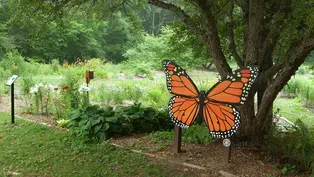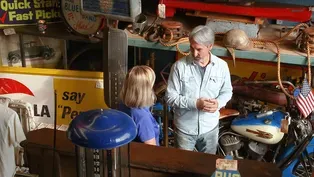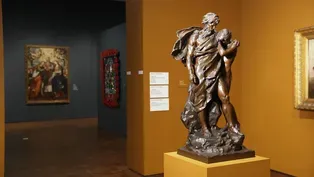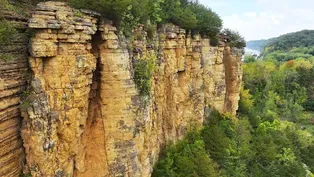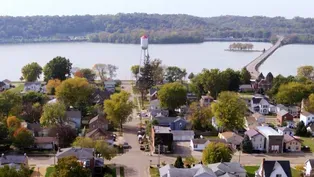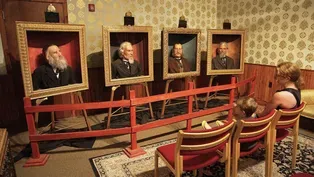
Great River Road National Scenic Byway - Central
Season 1 Episode 105 | 26m 45sVideo has Closed Captions
Explore highlights on Great River Road National Scenic Byway from Dubuque to Davenport.
Find breathtaking views at the Mines of Spain, pick your favorite vintage history in LeClaire, and study iconic art by Grant Wood at the Figge Art Museum along the Great River Road National Scenic Byway from Dubuque to Davenport.
Problems with Closed Captions? Closed Captioning Feedback
Problems with Closed Captions? Closed Captioning Feedback
Road Trip Iowa is a local public television program presented by Iowa PBS

Great River Road National Scenic Byway - Central
Season 1 Episode 105 | 26m 45sVideo has Closed Captions
Find breathtaking views at the Mines of Spain, pick your favorite vintage history in LeClaire, and study iconic art by Grant Wood at the Figge Art Museum along the Great River Road National Scenic Byway from Dubuque to Davenport.
Problems with Closed Captions? Closed Captioning Feedback
How to Watch Road Trip Iowa
Road Trip Iowa is available to stream on pbs.org and the free PBS App, available on iPhone, Apple TV, Android TV, Android smartphones, Amazon Fire TV, Amazon Fire Tablet, Roku, Samsung Smart TV, and Vizio.
Providing Support for PBS.org
Learn Moreabout PBS online sponsorshipKohlsdorf: For this episode of "Road Trip Iowa"... Hey, what's going on?
...we're traveling Iowa's portion of the Great River Road from Dubuque to Davenport.
We'll visit riverside communities thriving with history, enterprise, and art.
I want people to feel like antiques, that word isn't intimidating.
Mm.
Next on "Road Trip Iowa."
Woman: Kwik Star is proud to be a part of Iowa communities across the state.
Family owned for over 50 years, we’re dedicated to treating our guests, employees, and communities as we would like to be treated.
Man: Musco Lighting is an Iowa company that travels across the U.S. and to more than 125 countries to light community recreation fields, stadiums, airports, monuments, and more.
While our reach is global, we’re committed to our local communities.
♪♪ ♪♪ ♪♪ The Great River Road is a National Scenic Byway that covers 3,000 miles along the Mississippi River, from Minnesota, all the way down to the Gulf of Mexico.
This scenic drive covers Iowa's entire eastern border.
Today, we're traveling from Dubuque to Davenport.
Let's take a look at our itinerary.
We'll spread our wings at a state park in Bellevue, get a scenic view of Iowa's only island city, explore Iowa's history in the logging industry, and we pick through the highlights of a thriving community.
We begin just south of Dubuque at the Mines of Spain, where history is revealed in layers.
♪♪ ♪♪ ♪♪ The Great River Road offers no shortage of American history for travelers to explore, and there is plenty to be dug up at the Mines of Spain Recreation Area, just south of Dubuque.
♪♪ ♪♪ Nearly 1,500 acres of woodlands, wetlands, prairies, and limestone bluffs invite travelers to take in the area's history with breathtaking views of the Mississippi River.
♪♪ The earliest-known settlements in the area date back to prehistoric times.
More recently, Native American tribes like the Meskwaki settled the area, mined for lead, and developed trade routes along the Mississippi River.
Mining was expanded after the arrival of Iowa's first European settler, Julien Dubuque, in 1788.
A land-grant deal with the regional governor allowed Dubuque to mine nearly 1,400 Spanish-owned acres and stipulated that the area be called "Mines of Spain."
The mines proved crucial during wartime, providing lead for munitions from the American Revolution to the Civil War.
Today, Great River Road travelers can dig deeper into the history, thanks to six miles of hiking trails.
The Horseshoe Bluff Nature Trail provides sightseers with a diverse list of views... from wetlands and prairies to towering limestone bluffs and scenic overlooks.
Interpretive signs along the trail guide hikers through the Mines of Spain's unique geological history.
♪♪ ♪♪ [ Birds chirping ] Travelers craving beautiful scenes along the Great River Road can find a plethora of views at Bellevue State Park.
The park has been in existence since the 1920s and is a direct result of Jackson County residents wanting to preserve the beauty of the area.
They actually raised $5,000 as a community to purchase this land, and it was originally, I think it started at 37 acres, and they took it to the Conservation Commission or the board, state of Iowa, and they said, "We'll sell it to you for a dollar."
So, the state purchased it for a dollar.
Kohlsdorf: Divided into two units, Nelson and Dyas, the park invites visitors to explore the historical landscape with eight miles of walking trails.
Lindberg: If you can wake up between, oh, it depends on the time of year, but probably 4:00 or 5:00 in the morning, you can get a nice, pretty sunrise.
And then sunsets, again, are gorgeous, as well.
The Jackson County bluffs and the terrain that we have, unique terrain, I should say, that we have around here -- you're going to go down into valleys, and you're going to come up the bluff.
So, it's very pretty, awesome trails that we have.
[ Birds chirping ] Kohlsdorf: One particular area drawing interest from visitors is the one-acre butterfly sanctuary in the park's Nelson Unit.
Lindberg: All these flowers, our primary purpose is to attract pollinators.
So, they're not all necessarily native to the state, but they do attract pollinators to the area.
♪♪ Some species of butterflies will actually utilize specific plants.
We'll take example the monarch butterfly.
It will use the milkweed seeds or milkweed plants.
Comes over, pollinates them.
Milkweed, unfortunately to all others, are considered poisonous.
So, the monarch kind of thrives on that one plant.
They'll lay their eggs.
Their eggs thrive off of the milkweed flower or the plant itself, and they create their little chrysalis.
And then we have monarchs.
♪♪ Kohlsdorf: Run primarily by volunteers, the garden's mission promotes Iowa's historic prairie landscape and encourages travelers to understand the importance of bees, butterflies, and other pollinators.
Lindberg: We're creating a space for pollinators.
Pollinators are great.
So, imagine everything that you eat around here has to be pollinated, especially in your garden, to produce any kind of fruit.
So, think of raspberries have to be pollinated.
They start off with a flower.
Anything in your grass that grows, like clovers, pollinated by bees.
So, flowers are also pollinated, not only by butterflies, but bees, ants, moths to pollinate some.
So, pollinators are important.
♪♪ Kohlsdorf: The park also provides a scientific side to one of its more prominent pollinators, the monarch butterfly.
♪♪ Lindberg: When you come to visit us, we have different species that kind of visit.
So, we have up to about 60 species of butterflies that come and visit our area.
A lot of them might be the little smaller ones that you don't necessarily see on a day-to-day basis, but as they come through, monarchs are a very prevalent one.
We do some tagging here.
We work with volunteers.
We'll tag them to assist in conservation efforts, just to kind of see what we can find out about monarchs and as they go across and make their way down to Mexico and their way back.
Kohlsdorf: Whether you want to learn about the limestone bluffs of Jackson County or the diverse prairie plant life along the Mississippi River, Bellevue State Park is home to many learning opportunities for Great River Road travelers.
[ Insects chirping ] ♪♪ Treasures along Iowa's portion of the Great River Road come in all shapes and sizes, each with a unique story to tell.
One of the tales found in Jackson County is Iowa's only island city, Sabula.
Established in 1835, Sabula attracted industry with its proximity to the Mississippi River.
The town underwent a dramatic transformation in the 1930s, when the construction of Lock and Dam 13, downstream in Clinton, flooded the wetlands and lowlands around Sabula, creating Iowa's only island city and the Sabula Lakes.
The U.S. Census Bureau counts Sabula's population as close to 500 residents.
That number climbs throughout the year as birds and birdwatchers arrive to explore nearby marshes and wetlands.
♪♪ Clinton, Iowa, was once known as the "Lumber Capital of the World."
The titans of this local industry were known as lumber barons.
Thanks to our next stop, you can learn their story straight from the source.
♪♪ Journeys along the Great River Road National Scenic Byway provide travelers with a front-row seat to the Mississippi River's role in shaping the West.
A great learning stop can be found in Clinton at the Sawmill Museum.
A lot of people don't know that Clinton is actually a big part of the entire country's lumber industry, especially in the late 1800s.
The Sawmill Museum is basically conceived to tell that story and share it with people around here.
Kohlsdorf: From the 1850s to 1900s, Clinton, Iowa, played a critical role in the western expansion of the country.
Clinton is right here on the Mississippi River.
We're kind of one of the more older towns in Iowa, just with the exploration of people moving westward.
And so, with the lumber industry, we were kind of really in the right place, right time, right here on the Mississippi.
You know, we're in between like, Minneapolis and St. Louis and then also Chicago and Omaha and then further west.
Kohlsdorf: The Sawmill Museum provides visitors with a hands-on experience through a variety of exhibits.
Mossman: We have a lot of really fun things, especially for interactive for kids.
We have our cabins, if you want to try and get an idea of life at a lumber camp when they were cutting down the trees.
Now, gentlemen, look sharp!
We have animatronics of our lumber barons, where you can come and watch a show.
We have a really fun, interactive water table, where you can go and simulate what it was like for rafters going down the river, bringing the lumber from the lumber camps down to the sawmills here in Clinton.
And we also have a really fun, interactive video game of that log-raft ride, where you get to control your own log raft and try and get down to Clinton losing as few of your logs and your people as possible.
Kohlsdorf: A staff of volunteers helps the Sawmill Museum stay afloat in numerous ways.
Mossman: We actually have people who are volunteers.
They come in.
They help with fixing and building some of the things for the museum.
Some of them actually also use the equipment to build some of the things that we sell in our gift shop.
Kids love it here.
There's so much for them to, like, do, and play.
Even though it's kind of a small museum, we make sure that there's a lot of engaging and interactive things that they can do.
Ivers: Here at the Sawmill Museum, we do kind of want to unearth it for people to know.
A lot of people aren't necessarily aware of exactly what happened.
We're known as, like, the lumber capital of the world, but a lot of people don't know exactly what that means or what happened here.
So, it's kind of our mission to bring that local history to life for people that live here, people traveling to learn about it.
♪♪ Kohlsdorf: For over 30 years, people have been visiting the Clinton Area Showboat Theatre for summertime shows.
Davis: The Showboat has been a rich part of Clinton for quite a few years now.
It's not just the community that's invested in this place, but it's a lot of our returning individuals who really like this place.
♪♪ Kohlsdorf: In the 1990s, the boat was dry-docked as part of a flood-mitigation project from the Army Corps of Engineers.
After being permanently moored in the dike, the showboat became ingrained into the landscape of the city of Clinton and the hearts of the community.
♪♪ It's kind of encouraging to see a community, you know, take ownership of this unique theater space that we have.
Kohlsdorf: Those traveling on the Great River Road can catch a show at the Clinton Area Showboat Theatre in the summer months from mid-June through the first week in August.
Named for the town's famous son, "Buffalo" Bill Cody, Cody Road in LeClaire is a great place for travelers to stop and stretch their legs.
With restaurants, boutiques, and even celebrities, this riverfront offers plenty of local culture to explore.
♪♪ Nestled next to the mighty Mississippi, this historic town experienced a revitalization in the early 2000s thanks to a shared community vision.
Hey, what's going on?
He's got a couple of Harleys for sale.
Okay.
Old ones?
Kohlsdorf: To learn more, we turn to Mike Wolfe, host of the long-running TV show "American Pickers," whose energy and innovation helped put this small town on the world stage.
So, this is Antique Archaeology.
This is random chaos.
You got a lot going on in here.
You know, that's the biggest thing.
You know, we don't have a lot of square footage and a lot of people, when they come in here, they're like, "Oh, my gosh, it looks so big on the show."
And I'm like, "Well, there's big ideas here."
I want people to experience some of the things that I have over the years.
And so, when they see me pulling something like this out of a barn, like this old Indian, they don't ever get a chance to, like, actually see it and touch it.
And I think that's intriguing to a lot of people.
Right now the show is in 63 countries, and so we get people from literally all over the world.
Since we're so close to Chicago, they can fly into there, and then they travel on I-80.
And so, downtown LeClaire here, this area, we're only a mile and a half off of I-80.
So, we're drawing a lot of people.
And that's a huge thing for me because, you know, I was involved with city council and I was on the tourism board.
And I understand how all of those things have to plug into our downtown, our Main Street, to make that happen.
Okay, so we built this building about seven years ago because, obviously, you can see there wasn't a lot of space next door.
And, you know, we did brick walls inside.
The ceiling's pickled.
There's a lot of natural light.
And I wanted to kind of create a space that, like, the things that, you know, the areas that I find things in.
Mm-hmm.
Yeah.
I want people to feel like antiques, that word isn't intimidating.
Mm.
Because when you say that word, they're like, "Well, that's...
I don't know anything about that.
That sounds expensive," or "I don't really know what to pay."
And so that's what you want for people who come here.
You want that experience for them of being able to see some of these finds and see what's out there.
For that short, little moment that we have people's attention, you know, I want to be impactful.
♪♪ Kohlsdorf: That impact has helped create a momentous movement of new establishments along Cody Road.
LeClaire has a lot of really unique things to offer.
One, we are right on the Great River Road.
Our Main Street's right on it.
We have retail shopping.
We have a lot of great restaurants.
We have wine bars.
We have a distillery.
We have a brewery.
All that's going on.
But the best thing that we've got is we have no levee.
We have no dam walls.
You can literally walk down to the shore and dip your toe in the water.
The river, you have full access.
You have full access of this river visually, which is really incredible.
Yeah, and not a lot of places have that.
So, you could go all the way to McGregor down to Keokuk, and it would be difficult to be on Main Street and be right on the river.
You know, "Buffalo" Bill played here as a child.
We have the Buffalo Bill Museum.
We have one of the last wooden-hull paddle-wheel boats on display in that museum that worked on this river.
You know, there's just so much tremendous amount of history here.
This place right here is beautiful, this LeClaire River Loft.
So, you can stay right downtown above a coffee house with a big porch and look out over all of this in the morning and kind of take it all in.
Kohlsdorf: Let's go and take in a few other things that LeClaire has to offer.
Our first stop, the Mississippi River Distilling Company, which has become a popular spot along the Great River Road.
For some reason, when we came down Highway 67 and hit that bend in downtown LeClaire, and you see the streetlights and you see the river and the antique downtown, it was just like, "Oh, this belongs here.
This is the place."
The distillery brought something new, you know, to antique shops and clothing stores, things like that.
It then kind of led itself to some more of that stuff.
Boom, we get a brewery next door.
We have a winery down the street right now.
We call it "Libations Lane" now that you can walk from all three, and it just brings an atmosphere and an energy when you can bounce around.
And then it provides for great nightlife with the restaurants and things like that that we have going.
So, the rising waters float all the boats.
Collier: Right now we're at the north part of the downtown in LeClaire.
My wife and I, Kim, decided to purchase this last May, and it's Root 67 Shops.
We have four tenants in here.
We've got Buttercupp Candles, the Nest, modern-day general store, the Clothing Company.
And then we have Cody Rose Flower Company, as well.
This property, which has been underutilized for such a long period, is really a key piece to utilize what's here, not let it sit empty for a number of years, and really try to bring in a younger crowd into LeClaire with giving them an opportunity of a storefront.
Kohlsdorf: Mike and I are stopping in at his friend's shop in a building he helped restore.
Wolfe: Emily.
Gwin: Hi!
Hey!
We have a visitor in town.
Ooh, this is a cool place.
And I wanted to show her your store because it's so incredible.
Yeah!
What is this?
Where are we?
Gwin: This is Emily Found It.
It's my vintage boutique.
Wolfe: I restored this building, and while I was restoring it, Emily and I had worked together for 12 years.
And she would come down, and she'd take pictures of the building, and then she's like, "The building's so cool.
It's so cool."
And then one day she came to me and she's like, "It's so cool.
I want to quit, and I want to open my own store."
And I was like, "What?!"
You know?
And so, she's been doing it, and I love it.
Kohlsdorf: LeClaire is part of the Great River Road.
Why do you think people should stop here?
So, LeClaire really has a lot of tools in their toolbox when it comes to tourism and bringing, you know, the masses to our town and to the Great River Road here.
And I think, you know, just being a small bit of that, having a shop here that specializes in vintage and kind of unique off-the-wall items, it kind of just brings this whole experience into a clearer picture.
Does small town matter?
Like, this is authentic.
This is what people want.
If you want to come down and meet the guy who made your whiskey and talk to the lady who, you know, ordered these clothes and did this and that curated these knickknacks that you're buying and these antiques, and talk to the chef and all those, that happens in LeClaire.
That happens in places like this.
And rural Iowa can offer something that no city in the country can when we put our best foot forward.
♪♪ ♪♪ ♪♪ ♪♪ The Figge Art Museum is the premier art and arts-education facility between Chicago and Des Moines.
♪♪ Kohlsdorf: Art lovers traveling along the Great River Road in Davenport have plenty of subjects to enjoy with a stop at Figge Art Museum.
Hargrave: Our building is home to one of the Midwest's finest art collections.
We present over 20 world-class exhibitions each year, covering all the time periods, media, and subject matter.
♪♪ Kohlsdorf: The museum was founded in 1925, when the city of Davenport received a donation of over 300 paintings.
Today, the Figge Art Museum houses collections from Spanish and European art to 19th- and 20th-century works by American artists.
We really think that it's important to not only serve people within our walls but to meet people where they're at, and that's something that we strive to do.
Kohlsdorf: Along with showcasing many unique works, the Figge Art Museum provides workshops and cultural partnerships with Ballet Quad Cities, Quad City Symphony, and Quad City Arts to further enrichment opportunities for its visitors.
♪♪ The museum is also the repository for the works of a famous Iowa artist.
Hargrave: Grant Wood was one of the most well-known regionalist artists, and we're, of course, lucky enough to have the Grant Wood Archive here.
♪♪ Kohlsdorf: The archive encompasses 249 pieces of art and memorabilia from Iowa's most celebrated painter.
♪♪ ♪♪ Hargrave: We at the Figge believe that art is for everyone, and so we design our exhibitions and our programs to be inviting and inclusive.
From natural history to arts and culture, the Great River Road offers the perfect path to explore Iowa's quaint riverfront communities.
We mined history lessons in Dubuque, learned logging firsthand from Iowa lumber barons, experienced the vibrancy of river communities, and visited modern art in one of Iowa's founding cities.
We hope you discovered something new on the Great River Road and feel inspired to get out and see it for yourself.
For more on the culture, history, and landscapes along Iowa's scenic byways, join us next time for "Road Trip Iowa."
♪♪ ♪♪ ♪♪ Woman: Kwik Star is proud to be a part of Iowa communities across the state.
Family owned for over 50 years, we’re dedicated to treating our guests, employees, and communities as we would like to be treated.
Man: Musco Lighting is an Iowa company that travels across the U.S. and to more than 125 countries to light community recreation fields, stadiums, airports, monuments, and more.
While our reach is global, we’re committed to our local communities.
Bellevue State Park Butterfly Sanctuary
Video has Closed Captions
Bellevue State Park encourages travelers to understand the importance of pollinators. (4m 16s)
Video has Closed Captions
Catch a show on the shoreline at the Clinton Area Showboat Theatre. (1m 19s)
Cody Road District in LeClaire
Video has Closed Captions
Experience a main street revitalization at the Cody Road Historic District in LeClaire. (7m 20s)
Video has Closed Captions
Art lovers can enjoy a variety of works at the Figge Art Museum in Davenport. (3m 5s)
Horseshoe Bluff at Mines of Spain
Video has Closed Captions
Dig up layers of Iowa history at the Mines of Spain Recreation Area near Dubuque. (2m 33s)
Video has Closed Captions
Discover the origin story of Iowa's only island city, Sabula. (1m 7s)
Video has Closed Captions
Learn Iowa's logging history straight from the lumber kings at Clinton's Sawmill Museum. (3m 6s)
Providing Support for PBS.org
Learn Moreabout PBS online sponsorshipSupport for PBS provided by:
Road Trip Iowa is a local public television program presented by Iowa PBS
